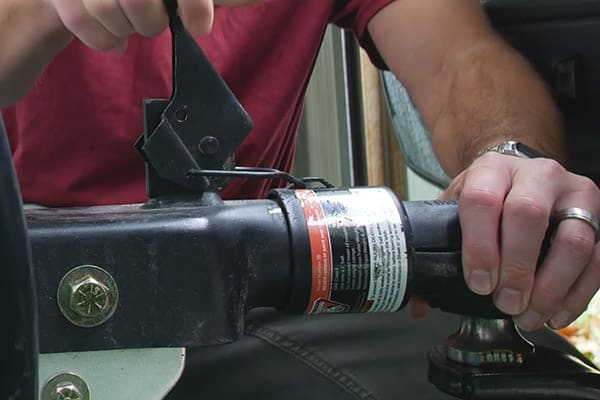How To Back Up A Trailer?
Backing up a trailer can be a daunting task for many, but with the right techniques and practice, it becomes much more manageable. Whether you're a seasoned traveler or new to towing, mastering the art of backing up a trailer is essential for safe and confident travel. In this guide, we'll walk you through the step-by-step process to show you how to back up a trailer like a pro.

Step 1: Trailer Connection
Prior to initiating the backup process, it is imperative to correctly connect your trailer. This stage holds utmost importance not only during backing-up maneuvers but also whenever you're getting ready to embark on a journey with your trailer. Improper trailer connections can result in accidents and hazardous situations on the road. Once the trailer is positioned on the hitch ball, securely fasten the chains in a crisscross or diagonal pattern. This guarantees that the chains will keep the trailer in place in the event of detachment. Additionally, always ensure that the latch on the coupling mechanism is firmly shut to prevent any mishaps. Finally, secure the mechanism with a pin to prevent the trailer from colliding with your vehicle.

Typically, when driving without a trailer, you might find yourself placing your hands on the upper section of the steering wheel. However, this hand placement can be counterproductive when towing a trailer. Given that the trailer moves in the opposite direction during turns, it's crucial to adapt your hand positioning. Grip the bottom part of the steering wheel to effectively manage the trailer's movements.

Backing up a trailer initially can induce stress, but proficiency comes with practice. It's vital to proceed slowly and methodically through the process. Regularly monitor your side mirrors and establish reference points to ensure the trailer aligns as desired. If the trailer exceeds the width of your towing vehicle, utilize the fender wheels as markers. Conversely, if the trailer is narrower, ensure it remains outside the scope of both side mirrors.
While having a rearview camera can be advantageous, it's essential to supplement it with your own assessment rather than solely relying on the camera.
While backing up in a straight line might seem simpler, practicing turning the trailer during reverse maneuvers is crucial, especially in tighter spaces. Utilize your side windows to aid in adjusting the trailer's position while moving backward. Extend your arm out to the window, lean out slightly, and maintain your grip on the bottom of the wheel. Proceed slowly and adjust your steering as necessary. If needed, don't hesitate to exit the vehicle and evaluate your progress. Remember, minor errors in your angles are expected, so keep moving forward, correct your positioning, and continue backing up.

Backing up on the passenger side can pose greater challenges since direct visibility is limited. Instead, rely on looking over your shoulder and utilize the rear window of your vehicle to focus on the trailer's rear end. Maneuver the trailer cautiously into the desired position and don't hesitate to move forward and readjust as needed. Prioritize safety over concerns about onlookers, maintain a relaxed demeanor, and back up with confidence.
Employing a ground guide positioned at the rear of the trailer can be immensely beneficial, particularly when backing up on the passenger side or navigating tricky angles. This individual can assess the situation and provide guidance accordingly. Communication can be established through verbal cues or hand signals, with the latter often being clearer and more efficient. For instance, if the ground guide gestures toward themselves, you should reverse. A hand signal bending to the right indicates backing up while steering right; bending to the left indicates steering left. If the guide forms an X with their hands, halt immediately. This method minimizes the need for verbal communication and ensures clarity in instructions.
While backing up with a trailer may initially seem daunting and attract attention, consistent practice leads to proficiency. Longer trailers afford more response time, making them slightly easier to maneuver, whereas shorter trailers demand quicker reactions and may necessitate additional practice. By mastering the art of backing up a travel trailer, concerns about spectators will diminish as you become adept at the task.

Why is a proper trailer connection essential before backing up?
Securely connecting your trailer is vital for road safety. Improper connections can lead to accidents or detachment, posing risks to you and others. Ensure chains are securely fastened and latches are closed.
How should I adjust my hand position when towing?
Grip the bottom of the steering wheel to manage the trailer's movements effectively, especially during turns.
What if I encounter challenges while backing up?
Take it slow, use side mirrors, and establish reference points. Seek assistance from a ground guide if needed for better maneuvering in tight spaces.
Mastering the art of backing up a trailer is a valuable skill for any traveler or outdoor enthusiast. By following the steps outlined in this guide and practicing regularly, you can build confidence and proficiency in handling your trailer with ease. Remember, it's okay to make mistakes along the way – they're all part of the learning process. So, take your time, stay focused, and soon enough, you'll be backing up your trailer like a seasoned pro. Happy travels!
Click on the following link to read another blog post: How To Backup Camera Installation?














